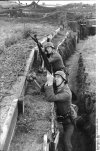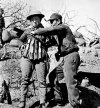I saw my German engineers were armed with some ineffective anti-tank weapon of which I had never heard of. Sorry I cannot remember the German right now. What it was: the heads of five or six of those potato mashers tied around one in the middle which would act as detonator. If you were eager to make it a short war for yourself, you could try getting close to a Soviet T-34 and knock the treads off it.
This makeshift solution was called "Geballte Ladung" (the best translation would be "bundled" or "concentrated load", means "charge") and was used against Allied tanks in WW1, already, in cases where Infantry guns or field guns had failed to stop the tanks, means where they had reached the German trenches.
In WW2, when German inf encountered tanks with sloped frontal armor (T-34) or tanks with relatively thick frontal armor (KV-2, KV-1, KV-1s) in Russia, they were usually unable to knock them out with their "doorknocking devices" (the PaK 38 AT guns), so they started to use that makeshift solution from World War 1 in defensive situations again, when Russian tanks charged towards and over their defensive trench lines.
Even though you think that these bundles could not damage more than just a track, those grenade bundles were actually effective if thrown/placed under enemy tanks, as the bottom armor of their hulls were not as thick as of those tanks that were produced later in the war (for instance, the bottom of a Tiger I consisted of 25 mm of armor, offering a sufficient level of protection against some AT mines and such improvised devices), but actually highly effective when placed on top of Russian engine compartments, and they were often the only tools at hand when defending trench lines or strongpoints early in the war, before sufficient numbers of 50 mm (and later on 75 mm) AT guns reached the frontlines.
In WW2, the usual procedure was to throw a bundle of grenades either under the tank (with a fair chance of damaging or penetrating the relatively thin bottom of 1940's and 1941's Russian tanks), or next to the tank (with a high chance of the enemy tank throwing a track), or (the most promising spot) even on top of the engine compartment behind the turret (quite a few soldiers knocked out Russian tanks that way, as the engines either caught fire or got knocked out instantly, it was a pretty bloody/risky business, though). While the Germans had to fall back on using the Geballte Ladungen (plural), they actually had a way better tool for close infantry AT-combat, already:
Hollow charges .... a cone with a magnetic base plate (used in 1940 for the very first time, during the para raid on the Belgian Fort Eben-Emael) , which could just be placed under a tank (the soldier had to let the enemy tank roll over him, so that he could place the charge somewhere on the bottom - say below the ammo racks or the crew compartment), but also anywhere else where the soldier could expect an effective penetration or damage (say on top of the engine compartment, on the thinner side armor - often with parts of the ammo racks right behind it - or even on the relatively thin rear armor with either the fuel tank or engine right behind it, etc.). If placed right, these HC cones delivered instant tank kills or immobilized tanks, usually.
The Germans were pretty reluctant to use/issue these hollow charges, at first, because they were scared of the possibility that the Russians/Allies could use the technology against their own tanks, especially against their upcoming heavy tank designs. It seems like the Germans became less reluctant, after they had figured that the US Army had deployed their own lightweight/handheld AT system (bazooka) in North Africa, and it seems like magnetic AT hollow charges then saw some more widespread use (in Leningrad and in Stalingrad, for example). The Germans put the famous "Zimmerit" coating/finish on their tanks, as protection against Allied magnetic mines/charges, even though the Allies - except for naval special ops - did not use the concept of magnetic charges.
The Russians only developed special HC grenades (with pointy tips and wings) that could be thrown by the soldiers, for instance, where then the RPG-6 (October 1943) was pretty much the counterpart (most likely copy) of the German Panzerwurfmine (PWM) introduced in May 1943, where the RPG-6 had cloth fins or wings serving as stabilizers, just like the PWM.
Whatsoever, the idea with the Zimmerit coating was to create as much distance between the armor surface and a potential magnetic mine base plate, but also to create a rippled, uneven coating, where flat mine base plates could not stick.
A rumor, which came up in 1944, saying that the Zimmerit coating could start to burn on (tank or AT) grenade impact, made the Germans cease to apply the coatings in September 1944, even though results of subsequent firing tests could discount that claim. The absence of Allied magnetic HC charges and the attempt to shorten the production cycle may have been other factors for the decision to do without Zimmerit coatings.
Later in the war, the Germans used only one stick grenade (either a Model 24 or a Model 43 stick grenade) and bundled it with several Model 39 Eierhandgranaten ("egg hand grenades", like in this picture, taken at the "Atlantic Wall" in 1943 or 1944), as it was easier to handle/throw these bundles:

Only the stick in the middle served as fuze/trigger.
A Nationalist Chinese soldier preparing for his suicide run against Japanese tank units, in 1938, wearing a vest packed with Model 24 stick grenades during the Battle of Taierzhuang (China), where a number of suicide bombers managed to get under Japanese tanks, ignite their suicide packs and knock out several tanks (at least 4?) instantly, in the process:

If I am not mistaken, in the South Corean movie "My Way", Corean - unarmed - soldiers pressed into service by the Japanese Army - do something similar during a scene depicting a major battle during the Russian-Japanese border incident (1938 - 1939), as these Coreans are forced to carry bags with explosives and run towards (and under or next to) the Russian tanks (BT tanks?) and trigger their charges, knocking out several Russian tanks in the process.
Not sure if this is an accurate depiction of the Battle of Nomonhan, but the Russian experiences during that conflict led to the development/design of the T-34, at least, as the Russian generals were not satisfied with the performance of their BT tanks.


